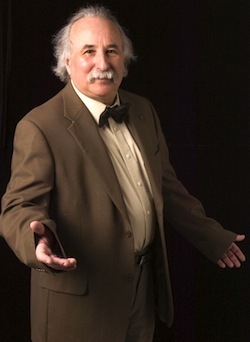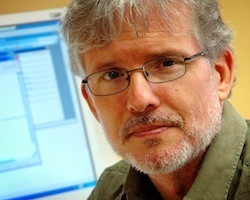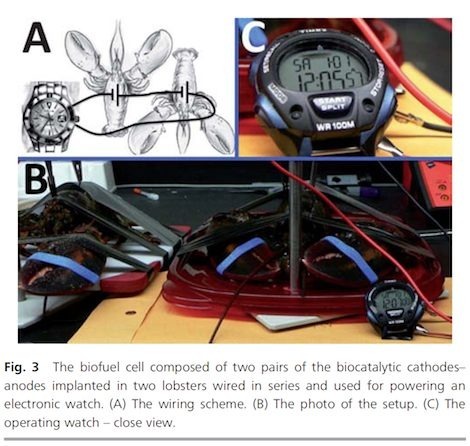Marc Abrahams's Blog, page 519
February 6, 2013
Falling Snowflakes: vertical or horizontal?
 In 2009, researchers at the Department of Atmospheric Sciences, of the University of North Dakota, US, presented (in association with the Instrumentation Sciences Branch, NASA Goddard Space Flight Center) details of their Snowflake Video Imager (SVI). It was fully described in a paper for the Journal of Atmospheric and Oceanic Technology.
In 2009, researchers at the Department of Atmospheric Sciences, of the University of North Dakota, US, presented (in association with the Instrumentation Sciences Branch, NASA Goddard Space Flight Center) details of their Snowflake Video Imager (SVI). It was fully described in a paper for the Journal of Atmospheric and Oceanic Technology.
The imager, which linked a CCD camera to a PC running specialised snowflake recognition software was not only able to classify snowflakes (as defined by the 1951 International Snowflake Commission) . . .

. . . but also revealed, for the first time, that :
“Snowflakes are twice as likely to be horizontally orientated rather than vertically orientated.”
Further details here, via the Precipitation Measurement Missions wing of NASA.

Culture: The spectacular anus of Joseph Pujol
Scholars in the field of cultural studies have curiosity that is wide-ranging. Witness this new study:
“The spectacular anus of Joseph Pujol: Recovering the Pétomane’s unique historic context,” Alison Moore [pictured here], French Cultural Studies, vol. 24, no. 1, February 2013, pp. 27-43. The author, at the University of Western Sydney, Australia, explains:
“Joseph Pujol, the ‘Pétomane’ performed to packed audiences at the Moulin Rouge in the early 1890s. By 1906 one of his contemporaries would remark that ‘this artist’s specialty was no longer in fashion’. When legal battles occurred between Pujol and the Moulin Rouge, newspaper commentaries were filled with hilarity that a man whose anus was the source of his income was now trying to gain a fortune from it. What might the spectacular anus of Pujol, and its pecuniary trials and tribulations, tell us about bodily imagination in late nineteenth-century France? Pujol’s idiosyncratic career has rarely been considered as an historical object; and when it has, the gaze has been light-hearted and filled with puns, much like those that surrounded him in his lifetime. But if the temptation to giggle is resisted for a moment, the Pétomane can teach us much about symbolic meanings that were ascribed to the anus in late nineteenth-century Paris.”
Here is a detail from the study:

Dr. Moore also wrote the study “Colonial Visions of ‘Third World’ Toilets: A Nineteenth-Century Discourse That Haunts Contemporary Tourism”. In Olga Gershenson and Barbara Penner (eds.), Ladies and Gents: Public Toilets and Gender (Philadelphia: Temple University Press, 2009), 97-113.

Renewable power source search: Lobsters
Moving on to lobsters, the team that is systematically exploring different varieties (see detail in text, below) of renewable power sources:

Co-author Evgeny Katz
“From ‘cyborg’ lobsters to a pacemaker powered by implantable biofuel cells,” Kevin MacVittie, Jan Halamek, Lenka Halamkov, Mark Southcott, William D. Jemison, Robert Lobel and Evgeny Katz, Energy and Environmental Science, vol. 6, 2013. The authors, at Clarkson University in Potsdam, NY and the University of Vermont College of Medicine, report:
“Enzyme-based biofuel cells implanted into living lobsters or designed as fluidic systems mimicking human blood circulation were used for powering electronic devices. Two lobsters with implanted biofuel cells connected in series were able to generate open circuit voltage up to 1.2 V and an electrical watch, selected as a model electronic device, was activated by the power extracted from the ‘living battery’….
“Based on our recently published reports on biofuel cells implanted in snails and clams, we implanted the biocatalytic electrodes in the American lobster (Homarus americanus).”
Here’s detail from the study:
You can hear Kevin MacVittie talk about this, on the Big Picture Science podcast.
(Thanks to investigator Paul Aughey for bringing this to our attention.)

February 5, 2013
American insight on accents: How to….
Linguistics, like all collections and studies of knowledge, is centered in and around the US. All Americans know that for a fact. The LearnTheAccent web site has both instructions and instructive examples, for Americans, of people speaking English with different accents. Here’s one — speaking English with an Italian accent. INSTRUCTIONS. EXAMPLE:

Recursive fury on the Internet
A new study tries to focus on fury on the Internet that’s defined by fury on the Internet:

Viren Swami, editor of the study
“Recursive fury: Conspiracist ideation in the blogosphere in response to research on conspiracist ideation,” Stephan Lewandowsky, John Cook, Klaus Oberauer and Michael Hubble, Frontiers in Personality Science and Individual Differences, vol. 4, no. 73, epub February 2, 2013. (Thanks to investigator Adam Orbit for bringing this to our attention.)
The article was edited by the remarkable Viren Swami (of breast and buttock ogling fame, among other fame) of the University of Westminster, UK. The authors, at the University of Western Australia, the University of Queensland, Australia, the University of Zurich, Switzerland, and Climate Realities Research, Australia, explain:

Lead author Lewandowsky
“Conspiracist ideation has been repeatedly implicated in the rejection of scientific propositions, although empirical evidence to date has been sparse. A recent study involving visitors to climate blogs found that conspiracist ideation was associated with the rejection of climate science and the rejection of other scientific propositions such as the link between lung cancer and smoking, and between HIV and AIDS (Lewandowsky, Oberauer, & Gignac, in press; LOG12 from here on). This article analyzes the response of the climate blogosphere to the publication of LOG12. We identify and trace the hypotheses that emerged in response to LOG12 and that questioned the validity of the paper’s conclusions. Using established criteria to identify conspiracist ideation, we show that many of the hypotheses exhibited conspiratorial content and counterfactual thinking.”
BONUS: An essay called “What Is Recursion?“

February 4, 2013
Spotlight on Unusual Research Institutes (part 2 of 2)
 Considerably less productive than The Central Institute for Questions and Answers in terms of the number of published research papers, but no less intriguing, is the The Malt Whisky Research Centre, Islay, Scotland.
Considerably less productive than The Central Institute for Questions and Answers in terms of the number of published research papers, but no less intriguing, is the The Malt Whisky Research Centre, Islay, Scotland.
As far as can be determined, The Malt Whisky Research Centre has only produced one scholarly paper – for the journal European Political Science, Volume 7, Number 3, August 2008 , pp. 318-323(6). In which authors R. S. J. Featherstonehaugh and J. S. R. Cholmondeley describe their findings regarding Urban Politics and Sex at Birth
“Science shows that 50 per cent of births in urban areas are male while 50 per cent in rural areas are female, and that this is a universal social pattern. Research on 4,473,559,500 live births in OECD countries, 1950-2000, demonstrates beyond all doubt that the party control of local councils has a statistically significant impact on sex at birth, as well as age at birth, sex of mother, and whether Lloyd George knew the mother.”
BONUS VIDEO
‘University Challenge’ (Scumbag College vs. Footlights Cambridge)
This concludes the short Improbable series on Unusual Research Institutes.

February 3, 2013
Ballet for machinery and a chair
Arthur Ganson‘s ballet for machinery and a chair:
(Thanks to investigator Vaughn Tan for bringing this to our attention.)

February 2, 2013
Spotlight on Unusual Research Institutes (part 1 of 2)
 The Central Institute for Questions and Answers (affiliated to the University of the Arctic Circle) has produced a swathe of scholarly papers. This one for example, published by the Social Science Research Center, Berlin, in their journal WZB-Mitteilungen, issue 115, March 2007, in which Professor Dr. Dr. I. Q. Besser-Wisser (author of the definitive five-volume History of the Rice Pudding) presents his ideas regarding The RoWoCo and Flea Theory :Truth Behind the Conspiracy (scroll to page 75 in the .pdf)
The Central Institute for Questions and Answers (affiliated to the University of the Arctic Circle) has produced a swathe of scholarly papers. This one for example, published by the Social Science Research Center, Berlin, in their journal WZB-Mitteilungen, issue 115, March 2007, in which Professor Dr. Dr. I. Q. Besser-Wisser (author of the definitive five-volume History of the Rice Pudding) presents his ideas regarding The RoWoCo and Flea Theory :Truth Behind the Conspiracy (scroll to page 75 in the .pdf)
“Wikipedia is a conspiracy of the Chinese government to gradually and slowly insinuate so many lies and untruths into western civilisation that it will eventually collapse, bringing down capitalism with it.”
For more examples of the Institute’s output, see :
The Schartz-Metterclume Method, by Dagobert D. Manteltasche and Otto I.Q. Besser-Wisser (Journal of Theoretical Politics, January 2002 vol. 14 no. 1), or
An Appreciation of the Pioneer of Post-Distanciationalist Politometrics. by Otto I.Q. Besser-Wisser:
(PS: Political Science & Politics,December 1, 1999)
BONUS VIDEO:
Professor Bruce Bonjcer M.A. (University of West Drayton), presents Intermediate Archaeology – Unit 7
COMING SOON : ‘Spotlight on Unusual Research Institutes’ (part 2 of 2)

January 31, 2013
This Grand Canyon, and That One, and Those Others…
Earle Spamer of the American Philosophical Society has, over the years, written a series of Improbable Research reports about the Grand Canyon (beginning with his explanation of how to preserve the Grand Canyon from disappearing due to erosion — his solution: fill the canyon, at least temporarily, with plastic packing “peanuts“). In “Is the Grand Canyon a Fake?“, published in the March-April 2006 issue of the magazine, Spamer wrote:
In America, 43 states have at least one Grand Canyon. Seventy three nations boast a Grand Canyon or two. There are Grand Canyons in the bottoms of oceans, too. Nevertheless, only a small number of the world’s Grand Canyons are recognized by agencies of geographic nomenclature, such as the and the National Imagery and Mapping Agency. This still did not stop a few geographically challenged writers and bureaucrats from misplacing Arizona’s canyon altogether, calling it the “Grand Canyon of New Mexico,” “Nevada’s Grand Canyon,” and “Colorado’s Grand Canyon.” The Colorado transplant was sensationally replicated by the U.S. Postal Service in 1999 when they produced a full run of postage stamps portraying “Grand Canyon, Colorado.” All 100 million stamps were then destroyed.
The May 20, 1999 document “Review of the Printing Error in the Grand Canyon Stamp (RG-LA-99-001)” explains that stamp error, from the point of view of postal managers. The fuzzy images of the stamp shown here are reproduced from that report.
Google Maps recently gave all of us the ability to take a virtual wander through the most celebrated of the Grand Canyons. We urge you to do so, to see if you can spot any stray packing peanuts that someone (probably not Spamer himself) may have deposited there:

Belletristically: About his frog
Odd, thought-provoking messages arrive here after a new issue of mini-AIR goes out. This note came today:
FROM: Александр Фёдорович Ракитский
Re: [Mini-air] mini-AIR (Jan 2013): Clay Modeling & Chocolate Craving & Fraud Brainstorming
Same beautifully! Excelent! My frogs rumbles from envy!

Marc Abrahams's Blog
- Marc Abrahams's profile
- 14 followers






